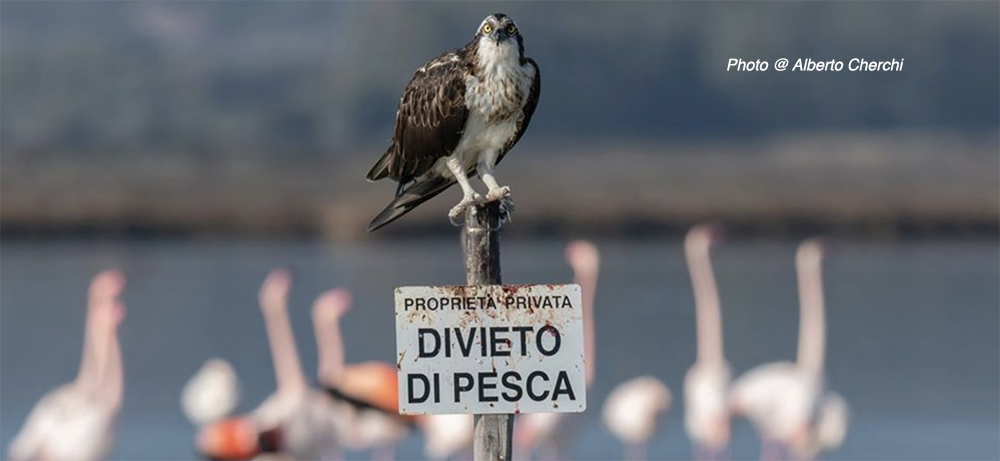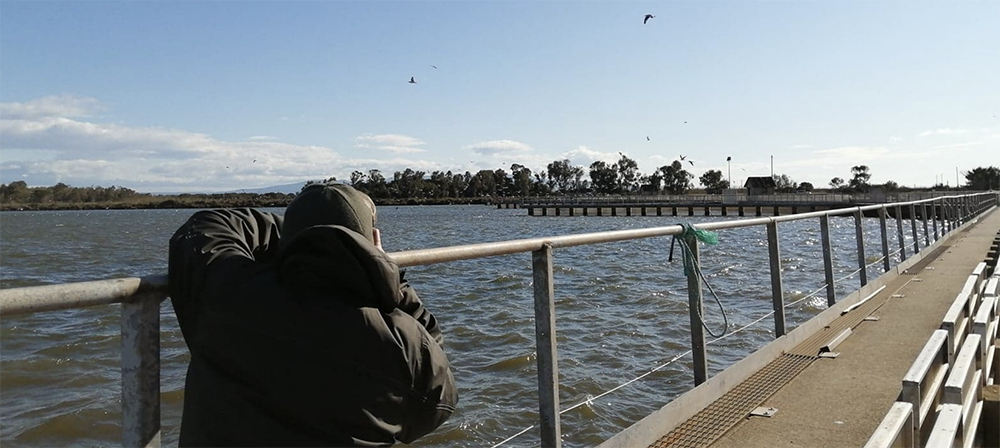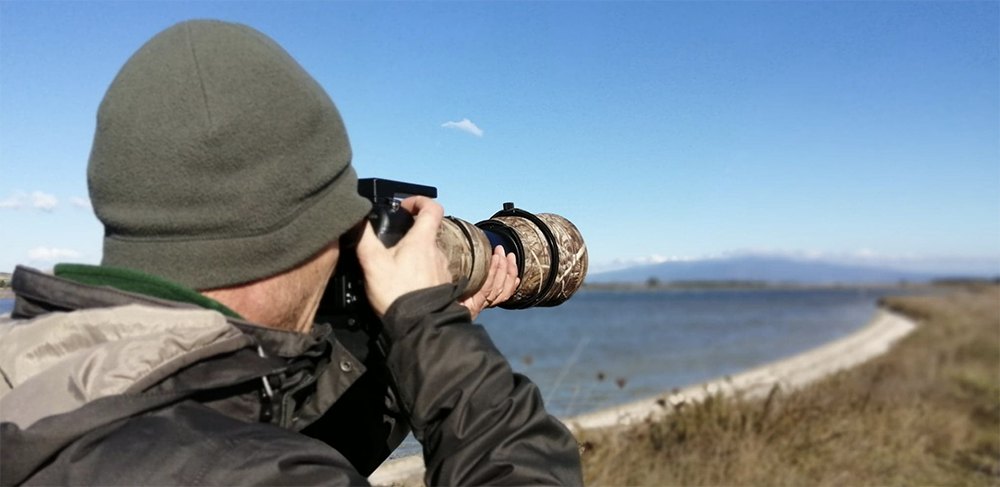The small off-road vehicle enters the track that runs along the banks of the Mistras lagune. Reeds, willows, bushes and a shady tunnel of pines parade through the window. Then the passage opens into the body of water, lightly blurred by the mistral wind. The pink multitude of flamingos helps to underpin the illusion of immobility. The hide is interrupted by the passage of the osprey, which crosses the cold blue of January flying past the first and second roost.
With his right hand Alberto Cherchi starts the engine, engages the gear and chases him jerking through the dirt holes. With his left hand he holds the camera where the body is tied to the huge lens, a long camouflage cone that reaches up to the shoulder. The hawk chooses the third wood planted on the pond’s bottom. On the edge of the lowered window, Alberto lays down what is the transfiguration of a tripod, a camouflage cushion of vague triangular shape, on which the lens rests. The shots follow each other with a machine-gun rhythm as a seagull immediately arrives, slow in circles at the base of the roost, ready to collect what remains of the prey.
“Today is the second time he has eaten. Often the seagulls don't just wait, but make an explicit request with a chirp", explains Alberto. Shaking it in its claws the hawk makes the small sea bream shine. Firmly in balance on the pole, it brings its head alive to its beak. In each image a detail of the splendid predatory spectacle is magnified: the wings spread or contracted, the royal or funny gaze, a verse of accusation or victory, the feathers separated by the water of the dive that still send drops around during the rapid movements of the meal. “We were lucky - Alberto explains - yesterday I had to wait for four hours before meeting a specimen. Then, in the end, ten minutes of adrenaline and 1300 shots".
The interest in birds was born in Alberto's early adolescence, but it turned into passion only years later, with digital cameras and powerful telephoto lenses, now unmovable from his camera. Little space for the wide angle, mostly used to catch atmospheric phenomena. That of Alberto is a sublimated form of hunting, a pursuit with a gentle outcome. Being on the blind, getting accepted or jumping on a camper and waiting the right moment for two days in a shed. Trips are not that frequent, though, in his routine: "The Oristano region is crossed by water. Where there is water there is life, a life that constantly changes with the seasons ". Flamingos, cranes, waders, plovers, sandpipers and in the spring feast the rare partridges and the grumpy oystercatchers.
But hunting down the hunter is what seems to excite more Alberto, who’s in contact with the German ringers to help thicken with his pictures the story of the old traveler G22, a hawk that has crossed Europe for twenty years, linking Oristano to Saxony. The day is blessed, another hawk darts along the bank. Alberto engages the reverse gear and runs backwards through holes and bumps. This time the prey is a mullet, and the operation on the pole is more complicated. The mullet has been grabbed by the tail and the shots retrace the acrobatic operations necessary to bring the claws on the head. Alberto communicates with his star as if he were in the studio between lights and reflective panels. He directs her almost trying to stimulate his movements. He laughs for an unexpected jump. Even the naked eye now registers a ruby spot in the small oblong figure. The seagull arrives on time for the mite. “Some time ago I managed to portray one that had fished a huge mullet, it will have weighed at least 800 grams. To make him more affable, he slammed him on the 'fishing ban' sign hanging from the roost".
We move between the structures of the Sa Mardini fish pond, where the mistral blows directly and raises the water in small waves. The pond is a continuous swarm of wings that fly over the dark shadows of the mullet herds. Alberto manages to see the figure and dance of the hawk, suspended in observation in the nebula of the other birds. Then the dive, which the machine freezes in a puff of water, and in the emergence of the wings. It is not the shot that is still missing in Alberto’s archive, despite the endless hours spent waiting and hiding: the figure thrown vertically and the moment in which the claws catch the prey in the explosion of water. “I don't think my photos are particularly beautiful. I have no particular ambitions. I am not particularly interested in publishing in specialized magazines. I show pictures on social media, I'm happy if people like them, I learn when they are criticized. I have to know the subjects I portray, and this has led me to study a lot, to improve my knowledge in books. Time ceases to exist when I am out with the camera. I walk through the land I love, I know it more and more in depth, path after path, bush after bush”.
The last foray is still for Mistras again, where three hawks hover high among the calls and a long white cloud that gradually unravels. A specimen lands on a distant pole. A crow floats around him croaking, as pestiferous queen of the pond. “The hawk is a calm type, despite the appearances. It never reacts". In a small bend in the pond, a young flamingo moves limping. He has a problem with one leg. By now many know him, photographers, birdwatchers, the LIPU (Italian League for Bird Protection), with whom Alberto is constantly in contact. The young white flamingo always visits that little corner of the pond, as if he felt protected. For a few weeks Alberto has often encountered a hawk with a completely trapped leg and lines. And a kestrel in the past, tortured by leg necrosis. He immortalized all stages of the loss. Now the pirate-kestrel eats mice and lizards on a wooden bench.
“I am always available for national and international photographers who ask me for information on places and species. We would need some additional infrastructure like signs, observation huts, information panels that make clear the right behavior to be followed. We live in a magical land and it would be nice to be able to share its treasures. It's what I like most about photography, sharing, disseminating beauty”.

The Island made of mussels in Corru Mannu's pond began to be populated by birds
Little tern, common tern, sandwich tern, rosy gull and black-winged stilt are some of the bird species that have found a home in Corru Mannu in recent weeks. Thanks to…

Sardinian Wetlands, the best way to protect them is "to manage them"
Cagliari, 04.02.2023 – Le zone umide sono ecosistemi acquatici sempre più rilevanti, conoscerli meglio è il primo passo per tutelarli, ma non è tutto. “Serve uno strumento di gestione” per…

The II D from Terralba Institute visited the Old Tower of Marceddì as prize for Terre d'Acqua school contest 2022
Learning about the role of these precious and very important ecosystems, as well as the specificities of the large wetland area of Oristano. In recent days we have accompanied the…

Maristanis was showcased at the Ramsar COP 14 on wetlands during a side event
The 14th meeting of the Ramsar Wetlands Conference (COP14) was held in Geneva from 5 to 13 November 2022, simultaneously also in Wuhan, China. At the International Conference Center in Geneva (CICG) all…

Learning from the Maristanis's model in the ENSERES's visit exchange
Two days to study an integrated management model of marine-coastal systems, two days to strengthen ties and develop new strategies for a sustainable future of the Mediterranean. The Italian stage…

A step forward for the Maristanis project, towards the Regional Park of wetlands in Sardinia
The Municipal Council of Oristano, on the proposal of the Councilor for the Environment Maria Bonaria Zedda, has launched the participatory process and the preparatory actions necessary for the establishment…

Evaluating ecosystem services by the TESSA Methodology in Arborea
How to understand the effects on natural capitals and actual and potential state changes of individual sites important in promoting decisions to support both biodiversity conservation and ecosystem service provision?

Terre D'Acqua 2022, the winners of the school contest within the Maristanis Project
With 87 works, of which 84 in the drawing category and 3 in the comics category, the MEDSEA Foundation's Terre D’Acqua 2022 Competition ends. The school contest took place from February…

The Sardinian farms met in Arborea under the sign of Sustainability
This is the year of relaunch for the La Fiera dell’agricoltura di Arborea (Agricultural Fair of Arborea), one of the most important thematic fairs in Sardinia that promotes the productive, agro and…

Maristanis in the news: Rai and Italia 1 dedicated ample space to the Maristanis Project
The Italian press gave ample space to the Maristanis project in recent months, the Oristanese wetlands and its most important project Maristanis were told in various national and local television reports on…

The winner of the World Wetlands Day in Sardinia 2022 Contest
With a picture taken in the Oristanese lagoons representing a group of flamingos and the sentence "They come / They come back / Sometimes they stop / Like nomads /…

Over 700 visitors for the World Wetlands Day Calendar
Over 700 visitors in the World Wetlands Day collective calendar, put together by the MEDSEA Foundation, as part of the Maristanis project last February, with the aim of promoting the precious…

The World Wetlands Day 2022 in Sardinia lasts a month, the events Calendar
As every year, the World Wetlands Day on the anniversary of the RAMSAR convention (of 1971, Feb. 2nd) calls and Sardinia, in particular the Oristanese area, replies within the Maristanis project that…

World Wetlands Day in Sardinia, from 2 to 27 February join the competition #WWDSardegna on Instagram
In the occasion of the World Wetlands Day which celebrates ponds and lagoons in the world next February 2, the MEDSEA foundation launches the contest on wetlands in Sardinia with the hashtag #WWDSardegna to…

MAVA Steering Committee in Provence: Sardinia was promoted with the Maristanis project
MEDSEA foundation, which has been carrying out the Maristanis project in the Oristano area in Sardinia since 2017, attended last week the yearly meeting of the MAVA steering committee. The session took place from 16 to 17 December 2021 in Châteauneuf-le-Rouge, in the Provence-Alpes-Côte d'Azur region, and gathered together the…

Terre d'Acqua, a wetlands school competition for students in the Oristanese
On February 2, the World Wetlands Day will be celebrated once again the Oristanese wetlands region. To recall the central role of wetlands in addressing climate and environmental crisis and to raise awareness of the importance of these basins especially in this west coast side…
- 1
- 2
- 3
- 4



